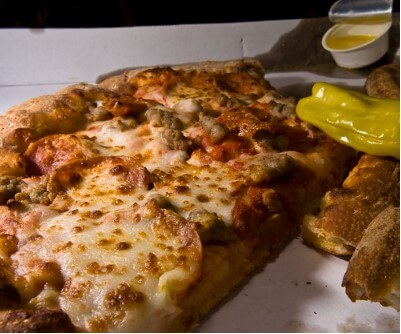
We’re yet to meet someone who doesn’t love a delicious slice of cheesy goodness in their mouth. If you’re anything like us, then you could eat pizza for the rest of your life, whenever and wherever you desire.
Some pizza newbies have restarted the debate about whether eating cold pizza is bad, and as the restaurant with the best pizza in Chicago, we sure have something to say about it.
Is Eating Cold Pizza Bad?
No, why would it be? Pizza, besides being the only pie in the world with the perfect balance of cheese, sauce, and bread, can also be consumed cold. We sell award-winning pizzas that taste delicious both hot and cold.
We know that it may seem confusing, especially because social rules dictate that most food must be eaten hot, but trust us when we say that you can eat pizza both hot and cold. You’d be surprised at the number of clients who prefer cold pizzas over hot ones.
So, as long as you follow the standard procedure for cold pizza and keep it at the recommended temperature, you’ll be more than okay.
How Can You Eat Cold Pizza Safely?

Day 68 by Chris Costes is licensed with CC BY 2.0
Our answer applies to both those who purchase our frozen pizzas and those who order several of our hot ones and want to save the leftovers for tomorrow (we understand, it happens to us too).
The first thing that you need to know is that pizza is a perishable food, which means that at room temperature, bacteria can breed and ruin it. This could be why many people have concerns about eating cold pizza.
However, if you leave your hot pizza at room temperature and consume it before the two-hour limit, you’ll be fine. However, if, for some reason, you leave your pizza at room temperature for over two hours, you should throw it out, as it could become a breeding ground for bacteria. We know, it hurts us to think about throwing out pizza too.
Now, if you want to save your leftovers, you should store them in a container or wrap them and then refrigerate them before the two-hour limit. If you’re not planning on eating the pizza leftovers the next day, consider storing your pizza in the freezer, as it can last one to two months that way. However, you should note that the flavor is likely to not be the same.
For best preservation, use temperatures between 40F and 14F.
Regarding our frozen pizzas, you can either microwave them and eat them hot or wait until the pizza isn’t too hot before refrigerating it to eat the next day. If you choose the latter, you should only do this once, as refrigerating them again can make the pizza go bad. Nobody wants that, right?
Is It True That Cold Pizza Tastes Different Than Hot Pizza?
That’s a big yes. Pizza, in our opinion, is one of those foods that tastes different, but in a good kind of different, the next day. That’s why millions prefer eating it cold.
As you may know, pizza has different layers, starting with the crust, followed by the sauce, cheese, and other toppings. When the pizza is hot, most of us can feel and differentiate each layer—which is still exquisite, don’t get us wrong, but it’s not what we’d describe as a homogenous eating experience.
With a cold pizza, however, all the ingredients have more than enough time to blend together to create a rich and addictive flavor.
Why Does Cold Pizza Taste Better?
Well, let’s start by saying that cold pizza is like marinating a chicken—the more time it spends soaking in all the herbs and sauces, the richer its flavor. With that said, let’s describe what happens to the standard ingredients in a cold pizza.
First, the crust gets soggy, as it has more time to absorb the sauce, while the cheese’s fat gets thicker, so you don’t feel the cheesy-fat effect that much. Then, the flavor of the tomatoes becomes less tart, and the scent of the herbs spreads all over the pizza. The crust becomes sweeter, and the overall fat in the pizza serves as a protective layer that keeps the flavor in.
In general, the texture of a cold pizza feels chewier, and the flavor is more concentrated. Do we need to say more?
How To Reheat Cold Pizza
If you decide to reheat your cold pizza, you don’t need to worry because it won’t make you ill. You just need to choose the right method. For example, if you only have two or three slices left, the best method is to use the stove or microwave. However, if you have an entire pizza or several slices, then it’s better to use the oven.
Keep in mind that one disadvantage of using the microwave is that the pizza will lose its moisture, which will result in a soggy pie with a stone-hard crust. However, using this method provides fast and efficient results.
If you only have a few slices and don’t want them to lose their moisture, then the stove is the best option, as the slices get evenly warm and don’t lose their natural texture. For a crusty result, add a bit of water to the pan before placing the slices in it and preheat them at a low temperature.
If you have several pizzas or slices, then the oven is a safe bet. Preheat the oven to 350F, wrap the pizza or slices in tin foil, and if you want a crusty effect, place the pizza or slices on a pre-heated pan.
Whether it’s cold, hot, or preheated, pizzas should be enjoyed in the way that you prefer. These pies are delicious, filling, and contain everything that you need in a meal. Just remember to always follow the standard procedure to avoid foodborne illnesses.
If you haven’t tried cold pizza yet, why not start with one of Chicago’s best pizzas?